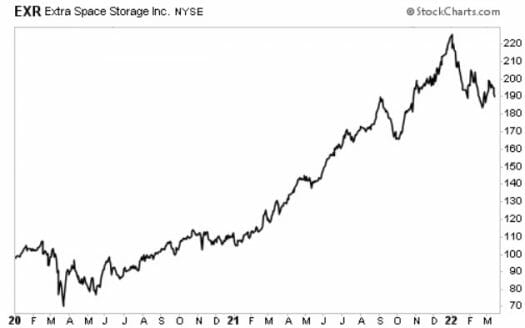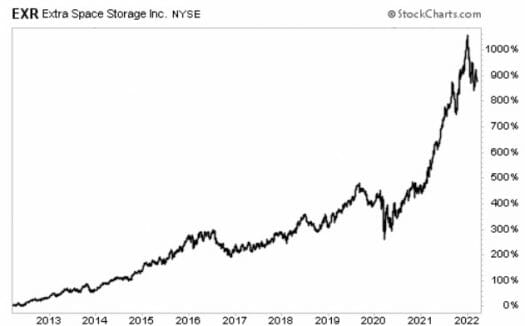This Under-The-Radar Asset Class Is Also One Of The Best-Performing On The Planet
Last week, I told my premium readers that my family and I have been house hunting during this crazy market.
I’ve been in the middle of this for about six months now. We’ve made several premium offers on properties that caught our eye, but there has always been an overzealous bidder willing to pay even more.
Like I said, it’s been crazy. Fortunately, the end is in sight. But I have to say, I’m not looking forward to moving.
If you’ve ever moved, then you can probably sympathize. And chances are your belongings didn’t all take a direct path to their final destination. Some of your stuff may have had a layover in one of the most underappreciated real estate assets around…
The Hidden Beauty Of The Storage Unit Business…
Microwave ovens. Lawn care equipment. Fishing tackle. Snow skis. You’d be surprised at the wide assortment of neglected things that end up in garages and closets. The easiest way to de-clutter is to move these seldom-used possessions into a storage unit.
Back in 1995, there were about 25,000 self-storage facilities nationwide. But they have been popping up at a rate of 1,700 per year on average. So the number of locations has already doubled to 50,000 and continues to grow. According to the Self-Storage Association, these warehouses contain 2.3 billion square feet of space for rent.
To put that figure in perspective, Minnesota’s cavernous Mall of America is roughly 5 million square feet — so we’re talking about more than 400 of those.
On average, there are about four new self-storage facilities opening per day. That expansion reflects growing demand from homeowners. You don’t open new facilities if older ones are empty. Even with capacity doubling over the past 15 years, national occupancy rates have remained stable around 85% — higher in some locales.
Meanwhile, average monthly rent for a standard 100 square foot unit has increased to around $85 from $56. According to real estate firm Cushman & Wakefield, the breakeven occupancy rate for a self-storage facility is approximately 40%, meaning even half-full locations can still turn a nice profit.
But every time a new unit is built, there is somebody waiting to fill it with their stuff — and the average lease period is 12 to 18 months. Safekeeping old bed frames and television sets may not be the most glamorous business. But these facilities are generating annual rental income in excess of $24 billion.
And that figure continues to grow.
The National Association of Real Estate Investment Trusts (NAREIT) examined stock prices over a 15-year period between 1997 and 2011. Over that span, it found that the self-storage property sector posted average annual returns of 15.4%, beating out apartments (13.7%), retail (13.5%), office (10.4%) and industrial (8.7%).
One Of My Favorite Picks To Profit
Extra Space Storage (NYSE: EXR) is one of the best in the business. Founded in 1977, the company has expanded through acquisition and now boasts a national portfolio of nearly 2,000 owned or managed properties from coast to coast.
These facilities contain 1.4 million individual rental units comprising 153 million square feet of space. Incidentally, that’s enough room to provide 12 square feet of storage space to every one of the 10 million residents in the state of Georgia.
As is common in the industry, ESS offers temporary discounts to help attract first-time renters. But once there, 60% of those customers stay at least 12 months and 40% stick around for 24 months. And thanks to rising demand, the company has been steadily increasing rental rates at a solid 5% to 7% annual pace over the past five years.
In turn, management has been able to double its quarterly dividend over the last five years – and it continues to climb. Thanks to robust demand, management recently approved a 25% hike to $1.25 per share, or $5.00 annually. The yield is a respectable 2.5%, but that generous (and well covered) payout only part of the story here. Over the past year, the shares have appreciated from around $100 (pre-Covid) to a peak above $220 before retreating recently.

And growth opportunities still abound in this fragmented industry. The top self-storage REITs own or operate only about one-fifth of the available storage square footage in the United States, leaving 80% of the sector ripe for acquisition.
Most competitors have been slow to adopt new technology. While many rely on hard copy ads, ESS was among the first to embrace social media, search engine optimization, algorithmic pricing models and data analytics. The company shares these best practices with all its new acquisitions, helping optimize their performance.
I also like that Extra Space Storage manages close to a thousand locations on behalf of third-party owners under contracts that are adding tens of millions in ancillary fees per quarter. Add it all up, and you can see why EXR has generated the strongest total return of any publicly-traded real estate stock over the past decade — and is widening the lead.

Closing Thoughts
If you’re interested in this space, then EXR is certainly worth considering. After pulling back to around $190, shares are a little more attractive from a valuation standpoint than they were before.
Still, its P/AFFO ratio (price-to-adjusted-funds-from-operation, which is a more appropriate way of valuing REITs), at about 25, is still higher than its 5-year average.
If shares pull back anymore, then it’s definitely one to put on your radar.
In the meantime, if you’re looking for safe high-yielders in this market, then you need to check out my latest report…
I’ve identified 5 safe, high-yield stocks that allow you to keep it simple. Each one has proven to hold up well in any market — providing stellar long-term returns and paying increasing dividends every single year.
You can forget about meme stocks, volatile cryptocurrencies, and complicated trading strategies… With picks like this in your portfolio, you may never have to worry about what the market is doing again…
